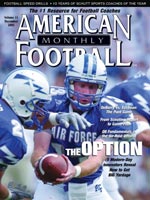AMERICAN FOOTBALL MONTHLY THE #1 RESOURCE FOR FOOTBALL COACHES
Article CategoriesAFM Magazine
|
Innovators of the optionby: Curt Block© More from this issue The number of coaches who are proponents of the option offense exclusively are like members of a select fraternity. They are relatively few in number and show mutual admiration for one another. The officers of this would-be Sons of the Option order might include Paul Johnson of Navy, Rice University’s Ken Hatfield, Mike Sewak of Division I-AA Georgia Southern and the Air Force Academy where Chuck Petersen is Offensive Coordinator. AFM spoke to all of them and others about their potent scoring machinery and its influence on the game. Few programs have experienced such a quick fix with the option that Kevin Wright achieved after he arrived at Warren Central High School in Indianapolis. The Warriors, who had basked in the good times of two straight state championships in the 80s fueled by prep phenom QB Jeff George, had run low on ....The full article can only be seen by subscribers. Subscribe today!
|
|
|||||||
| HOME |
MAGAZINE |
SUBSCRIBE | ONLINE COLUMNISTS | COACHING VIDEOS |
Copyright 2025, AmericanFootballMonthly.com
All Rights Reserved





